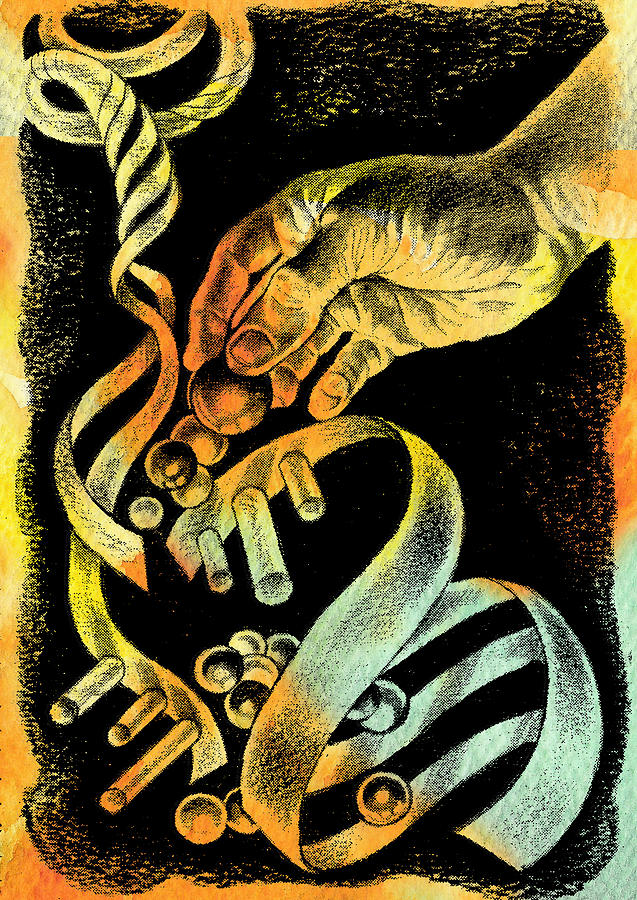Biotech Art -Week 6
| Genetically modified / Selective Breeding Animals |
This week’s content on biotechnology and art was quite fascinating to read about and ponder on. I personally think the concept of life isn’t considered a valid enough expressive medium, but rather an artistic concept or theme that art pieces can focus upon. Both mentioned in lecture 1 of this week and the article written by Ellen K. Levy “ biotechnology is constantly challenging the status quo of society” (Levy). New genetic modifications of food has allowed humans to taste different delicacies and experience food options that originally weren’t available during that season. Other forms of biotechnology altered animals and even human genome to create medical advances to increase the human life.
 |
| Genetically modified food example |
I do think the usage of biotechnology in selective breeding, or swapping DNA as seen in clones can be considered a form of art, but I disagree displaying it through the medium of a living creature (Vesna). This should be considered a purely scientific development that is done for a positive scientific advancement and not an expression of creativity or simply an artistic showcase. But this same development can be displayed through other mediums for instance drawings or paintings and thus be considered as an expression of creativity and art.
Adding on to the restrictions in the field of biotechnology, I agree with what was mentioned in lecture 5, on the questions regarding law enforcements towards biotechnology and expression of human creativity (Vesna). I think both on animals or plants, if their gene structure is going to be altered it should be based on the purpose of advancing and achieving a positive goal rather than pure experimentation. There shouldn't be a limit to expression on human creativity but there should be a limit to humans using the name of "creativity" but doing things that have moral concerns and lack positive purpose to society.
 |
| Gene Painting by Leon Zernitsky |
Genetically Modified Foods, learn.genetics.utah.edu/content/science/gmfoods. Accessed 7 May 2024.
Levy, Ellen K. “Defining life:” Context Providers, 27 May 2014, pp. 275–298, https://doi.org/10.2307/j.ctv36xvqqx.16. Accesssed 7 May. 2024.A
“Human Genetic Modification.” Center for Genetics and Society, www.geneticsandsociety.org/topics/human-genetic-modification. Accessed 7 May 2024. o
Ormandy, Elisabeth H, et al. “Genetic Engineering of Animals: Ethical Issues, Including Welfare Concerns.” The Canadian Veterinary Journal = La Revue Veterinaire Canadienne, U.S. National Library of Medicine, May 2011, www.ncbi.nlm.nih.gov/pmc/articles/PMC3078015/. ki, Keith
(2006), “The rise of intellectual property rights in seed germplasm,” Con/texts ofInvention, Cleveland, Ohio, 20–23 April, Society for Critical Exchange: Cleveland.Vesna, Victoria. “Biotech&Art pt1” Lecture. BruinLearn DESMA 9. Accessed 7 May. 2024.
Vesna, Victoria. “Biotech&Art pt5” Lecture. BruinLearn DESMA 9. Accessed 7 May. 2024.
“Genetic Engineering by Leon Zernitsky.” Fine Art America, fineartamerica.com/featured/genetic-engineering-leon-zernitsky.html. Accessed 7 May 2024.
Lewis, Tanya. “10 Times Scientists Genetically Modified Animals and Came up with Some Weird Results.” Business Insider, Business Insider, www.businessinsider.com/genetically-modified-animal-experiments-2015-10. Accessed 7 May 2024.
Sennebogen, Emilie, and Gallagher Flinn. “10 Common Genetically Modified Foods.” HowStuffWorks, HowStuffWorks, 17 Aug. 2009, recipes.howstuffworks.com/5-common-genetically-modified-foods.htm.
.
Hello Sherry,
ReplyDeleteI agree on your stance with how bioart should be used as well as its limitations. You said it well when you said "there should be a limit to humans using the name of "creativity" but doing things that have moral concerns and lack positive purpose to society". To me, it only makes sense to use these types of experiments if it is necessary for our society and serves a purpose. If hurting others could be prevented, we should not be using it just to express art, as there are other ways to do so.
Hi Sherry,
ReplyDeleteI like your post. It goes over the general ideas that were spoken in lecture and also touches on ethics as well. I wrote my blog about genetically engineered fruits because it seemed like a fairly harmless expression of art and biotechnology. However, I agree with you on the fact that if we are to modify animals' and plants' DNAs, we need to make sure we are making them better and more advanced. Even though merely testing on animals and plants is sometimes necessary, we should still keep it at a minimum.